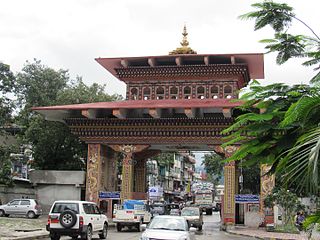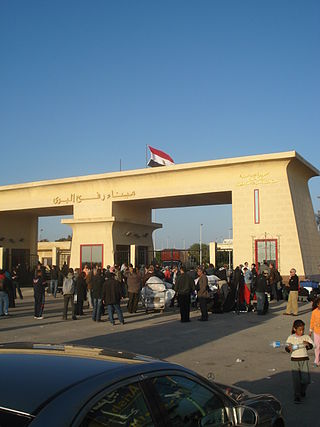
The Gaza Strip, also known simply as Gaza, is a small, densely populated territory located on the eastern coast of the Mediterranean Sea. It is the smaller of the two Palestinian territories. Gaza is bordered by Egypt on the southwest and Israel on the east and north.

The Palestinian Authority, officially known as the Palestinian National Authority or the State of Palestine, is the Fatah-controlled government body that exercises partial civil control over the Palestinian enclaves in the Israeli-occupied West Bank as a consequence of the 1993–1995 Oslo Accords. The Palestinian Authority controlled the Gaza Strip prior to the Palestinian elections of 2006 and the subsequent Gaza conflict between the Fatah and Hamas parties, when it lost control to Hamas; the PA continues to claim the Gaza Strip, although Hamas exercises de facto control. Since January 2013, the Palestinian Authority has used the name "State of Palestine" on official documents, although the United Nations continues to recognize the Palestinian Liberation Organization (PLO) as the "representative of the Palestinian people".

Border control comprises measures taken by governments to monitor and regulate the movement of people, animals, and goods across land, air, and maritime borders. While border control is typically associated with international borders, it also encompasses controls imposed on internal borders within a single state.

A visa is a conditional authorization granted by a polity to a foreigner that allows them to enter, remain within, or leave its territory. Visas typically include limits on the duration of the foreigner's stay, areas within the country they may enter, the dates they may enter, the number of permitted visits, or if the individual can work in the country in question. Visas are associated with the request for permission to enter a territory and thus are, in most countries, distinct from actual formal permission for an alien to enter and remain in the country. In each instance, a visa is subject to entry permission by an immigration official at the time of actual entry and can be revoked at any time. Visa evidence most commonly takes the form of a sticker endorsed in the applicant's passport or other travel document but may also exist electronically. Some countries no longer issue physical visa evidence, instead recording details only in immigration databases.

The Gaza–Israel barrier is a border barrier located on the Israeli side of the Gaza–Israel border. Before the Israel–Hamas war, the Erez Crossing, in the north of the Gaza Strip, used to be the only crossing point for people and goods coming from Israel into the Gaza Strip, with a second crossing point, the Kerem Shalom border crossing, used exclusively for goods coming from Egypt, as Israel didn't allow goods to go directly from Egypt into Gaza through the Egypt–Gaza border, except for the Salah Al Din Gate, opened in 2018.
Freedom of movement, mobility rights, or the right to travel is a human rights concept encompassing the right of individuals to travel from place to place within the territory of a country, and to leave the country and return to it. The right includes not only visiting places, but changing the place where the individual resides or works.

This article describes transport in the State of Palestine, which consists of two non-contiguous territories, the West Bank and the Gaza Strip, different parts of which are administered by Palestinian National Authority, Hamas Administration in Gaza and Israel.

The Allenby Bridge, known officially in Jordan as the King Hussein Bridge, and also called the Al-Karameh Bridge or simply Al-Jisr by Palestinian Arabs, is a bridge that crosses the Jordan River near the city of Jericho in the West Bank and the town of Al-Karameh in Jordan.

The Rafah Border Crossing or Rafah Crossing Point is the sole crossing point between Egypt and Palestine's Gaza Strip. It is located on the Egypt–Palestine border. Under a 2007 agreement between Egypt and Israel, Egypt controls the crossing but imports through the Rafah crossing require Israeli approval.

The Erez Crossing, also known as the Beit Hanoun Crossing, is a border crossing between the Gaza Strip and Israel. It is located at the northern end of the Gaza Strip, between the Israeli kibbutz of Erez and the Palestinian town of Beit Hanoun.

The restrictions on movement and goods in Gaza imposed by Israel date to the early 1990s. After Hamas took over in 2007, Israel significantly intensified existing movement restrictions and imposed a complete blockade on the movement of goods and people in and out of the Gaza Strip. Egypt began its blockade of Gaza in 2007, shortly after Hamas took control of the territory. The blockade's current stated aim is to prevent the smuggling of weapons into Gaza; previously stated motivations have included exerting economic pressure on Hamas. Human rights groups have called the blockade illegal and a form of collective punishment, as it restricts the flow of essential goods, contributes to economic hardship, and limits Gazans' freedom of movement. The blockade and its effects have led to the territory being called an "open-air prison".

The Palestinian Authority Passport is a passport/travel document issued since April 1995 by the Palestinian Authority to Palestinian residents of the Palestinian territories for the purpose of international travel.

Visitors to Israel must obtain a visa from one of the Israeli diplomatic missions unless they come from one of the visa-exempt countries. From January 2025, all visitors from visa-exempt countries must obtain an electronic travel authorization (ETA-IL) before traveling to Israel.

Tourism in the Palestinian territories is tourism in East Jerusalem, the West Bank, and the Gaza Strip. In 2010, 4.6 million people visited the Palestinian territories, compared to 2.6 million in 2009. Of that number, 2.2 million were foreign tourists while 2.7 million were domestic. In the last quarter of 2012 over 150,000 guests stayed in West Bank hotels; 40% were European and 9% were from the United States and Canada. Major travel guides write that "the West Bank is not the easiest place in which to travel but the effort is richly rewarded."

Kerem Shalom border crossing is a border crossing at the junction of two border sections: one between the Gaza Strip and Israel, and one between the Gaza Strip and Egypt. It is used by trucks carrying goods from Israel or Egypt to the Gaza Strip.
The gallery of passport stamps by country or territory contains an accurate alphabetical list of sovereign states, partially recognised states, and dependent territories with images of their passport stamps including visas. All Schengen countries and Cyprus use the same format for their stamps and stamps are not issued when traveling from one Schengen country to another, except for land border crossings to, from, and between Romania and Bulgaria.

Restrictions on the movement of Palestinians in the Israeli-occupied territories by Israel is an issue in the Israeli–Palestinian conflict. According to B'Tselem, following the 1967 war, the occupied territories were proclaimed closed military zones. In 1972, general exit orders were issued allowing residents of those territories to move freely between the West Bank, Israel and the Gaza Strip. Following the First Intifada by 1991, the general exit orders were revoked, and personal exit permits were required. According to B'Tselem, a measure of overall closure of the territories was enacted for the first time in 1993, and would result in total closures following rises in Palestinian political violence.

The Agreement on Movement and Access (AMA) was an agreement between Israel and the Palestinian Authority (PA) signed on 15 November 2005 aimed at improving Palestinian freedom of movement and economic activity within the Palestinian territories, and open the Rafah Crossing on the Gaza–Egypt border. AMA was described as: ″an agreement on facilitating the movement of people and goods within the Palestinian Territories and on opening an international crossing on the Gaza-Egypt border that will put the Palestinians in control of the entry and exit of people.″ Part of the agreement was the Agreed Principles for Rafah Crossing.
Visa requirements for crew members are administrative entry restrictions imposed by countries on members of a ship or aircraft crew during transit.
Controls imposed on internal borders within a single state or territory include measures taken by governments to monitor and regulate the movement of people, animals, and goods across land, air, and maritime borders through border controls.














